DBS, MRV, Tiablo A8, DX Cree Projection, WF-600, Regal WT1: RUNTIMES and pics!
This overview is my first throw and runtime comparison of the premium thrower lights (Dereelight DBS, Tiablo A8, and Lumapower MRV) and the budget versions (DealExtreme "3W Cree Projection" and WF-600). Scroll down for a detail review of the DBS V1 and Projection Cree.
For an updated detailed comparison to all the other thrower lights in my collection, please see:
Thrower review: DBS, Spear, MRV, Tiablo, Regal & clones: THROW, RUNTIMES, BEAMSHOTS!
The contenders:
From left to right: Lumapower MRV (2nd Gen), Tiablo A8, Dereelight DBS, DX Cree Projection, DX WF-600 (18650-only). Not shown is the Regal WT1.


Beamshots:
Quick and dirty comparison at ~.4 meters from a wall, to show you the different overall spillbeam patterns. All lights are running on 18650, with Q2 emitters.
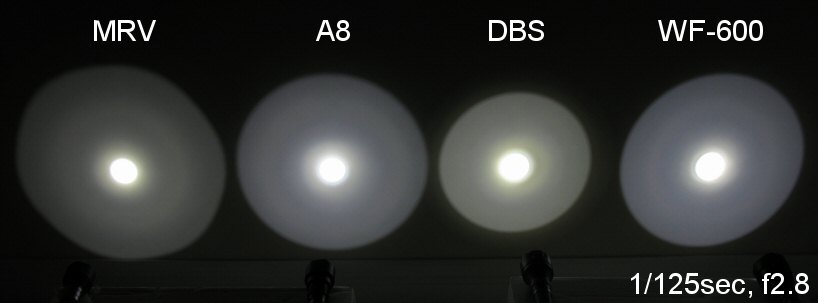
Beam observations:
MRV 1st Generation (Light Gray) - P4 Throw Lux @ one meter:
Throw observations:
Runtimes:
These runtimes charts are different from my other reviews - they represent throw, not overall output. Since my home-made milk carton lightbox doesn't accurately capture overall output on these intense throwers, I have adjusted all my relative output numbers to initial throw (measured as the squareroot of Lux @1m). This allows you to directly compare the relative throw of each light over time on the graphs below (although you can't directly compare these graphs with my other reviews).
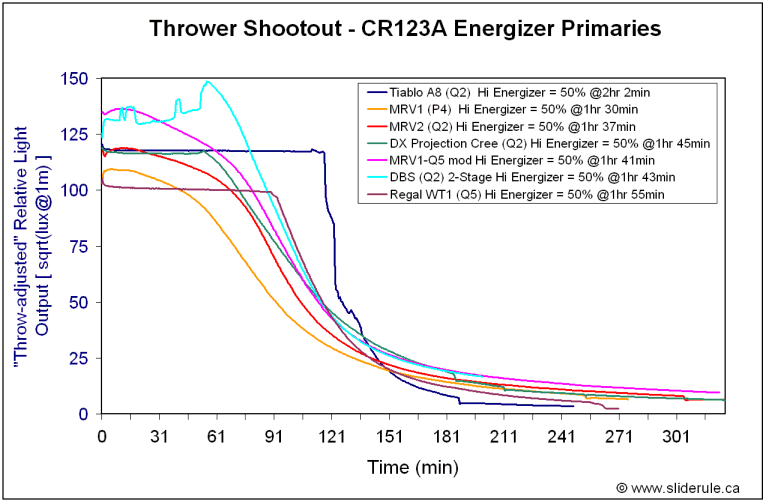
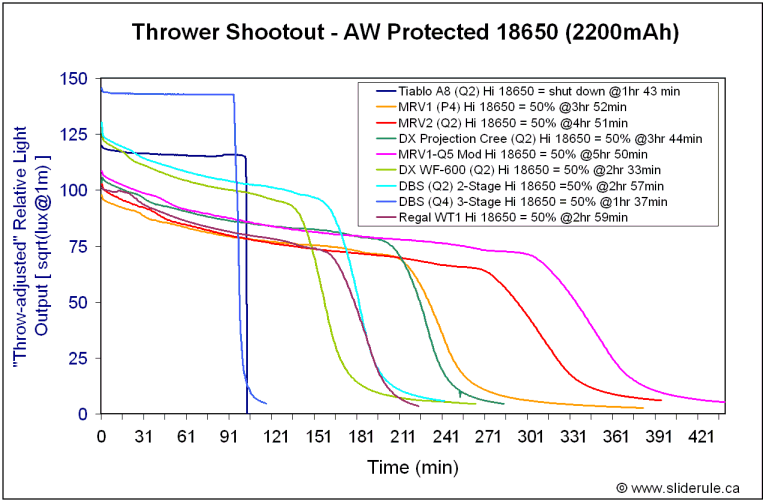
Runtime observations:
Conclusions:
------------------------
Dereelight DBS Mini-Review
Build Quality:
Machining and Anodizing:
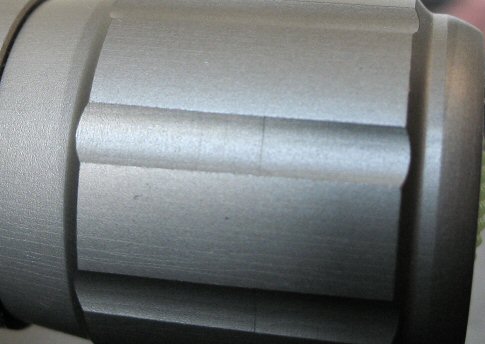
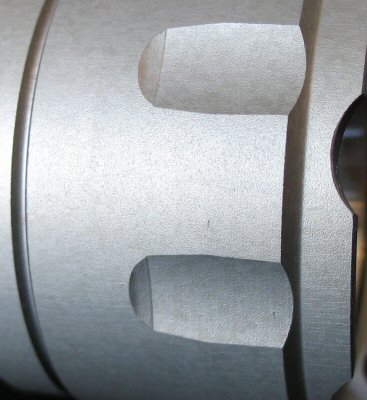
Body and threads:
Tailcap and switch:
DBS Summary:
-------------------------
Regal WT1 Mini-Review
I suggest you check out Stefan's excellent detailed review of this light for more info:
Regalight WT1 - A Massive Performer! With beamshots & Runtimes!
I agree completely with Stefan's assessment of the build quality of this light. Machining and anodizing are excellent, very substantial feel in the hand. I'd say overall build quality-wise, it's around the level of an MRV or Tiablo (which is higher than the DBS). Excellent marks all around. :thumbsup:
Light comes with a single-stage "tactical" forward clicky and an extra 2-stage reverse clicky (with resistored low mode, similar to most of the other other lights reviewed here). My 2-stage switch has exactly the same output as the single-stage on Hi. Light also comes with a OP reflector, wrist lanyward, and a basic-model holster.
The only slight negative on mine is the beam pattern. With the smooth reflector, the beam is ringier than my LP, Tiablo and DBS lights similarly equipped (the DBS was the previous "ringiness" winner among my lights ). More importantly, the emitter, while well-centered, doesn't seem to be lying completely level. The result is that up close, the major rings in the beam are not exactly centered around the hotspot, but rather slightly off to one side. The OP reflector helps hide this somewhat, but doesn't completely remove the effect. Note that the actual tilt of the emitter is subtle, and the lopsided effect of the rings is only really noticeable up close on a white wall and not in actual use. But it is there, and this is not something I've seen on my LP, Tiablo, or DBS lights.
). More importantly, the emitter, while well-centered, doesn't seem to be lying completely level. The result is that up close, the major rings in the beam are not exactly centered around the hotspot, but rather slightly off to one side. The OP reflector helps hide this somewhat, but doesn't completely remove the effect. Note that the actual tilt of the emitter is subtle, and the lopsided effect of the rings is only really noticeable up close on a white wall and not in actual use. But it is there, and this is not something I've seen on my LP, Tiablo, or DBS lights.
The conclusion here is that my Regal WT1 throws as far as my MRV-Q2 on 18650, and about as far as my MRV-P4 on primaries. It also has a very nice low mode (except on RCR, where it is similar to the MRV low). It's hard to estimate overall output on such throwy lights, but I'd say it seems to at least match that of my Q2 lights overall.
All in all, I'm happy with the light. Seems to be good value for the money. You basically get original P4/Q2 MRV output - with similar build quality - but in a smaller, more portable form-factor. :thumbsup:
-------------------------
Budget Thrower Mini-Review: DX Cree Projection and WF-600
Beamshots
For simplicity, I'm only showing the DX Cree Projection and Luma MRV-Q2 (2nd gen) on 18650 on Hi, at two different exposures to show the beam profiles.
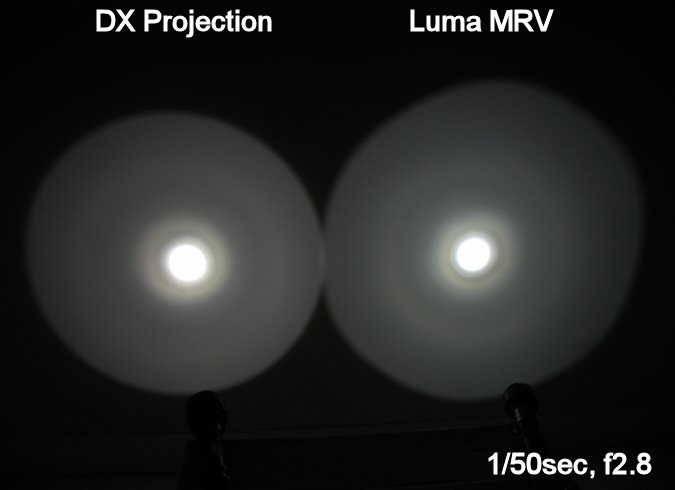
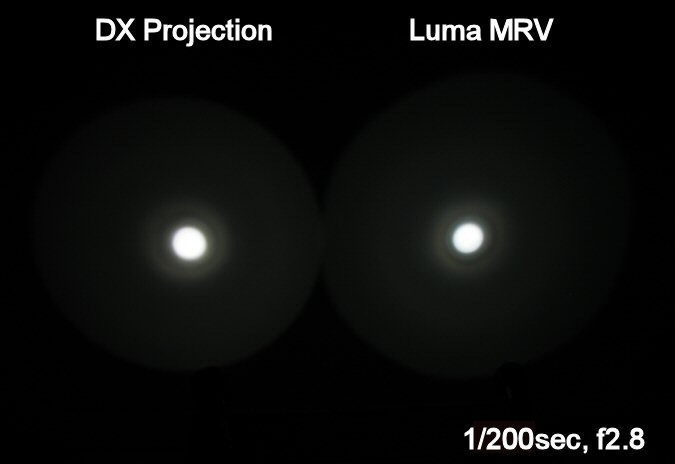
Reflector: The DX lights have a wider and longer reflector than the MRV (shown below), but are made of plastic instead of aluminum. They also have a wider opening, making it much harder to center properly around the emitter (the emitter simply has a shiny reflective disk surrounding it). On the MRV or A8, the reflector fits very snuggly around the Cree emitter ring, making proper placement a snap. The DBS is even better, as the emitter module actually screws into the reflector, insuring centering.
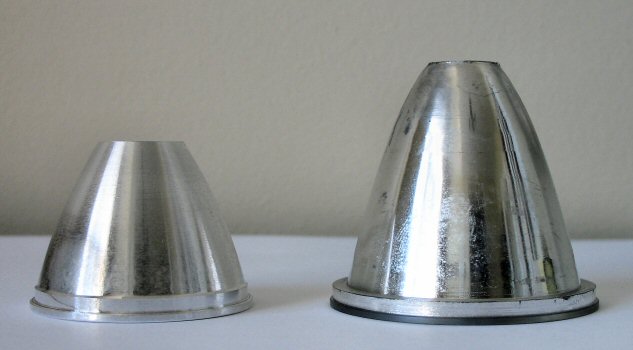

Body and threads: The DX lights have surprisingly good "hand feel", due to their overall heft. Although bulkier than the premium lights, the DX units seem well balanced in the hand, and the Type II anodizing is smooth on the visible surfaces (premium MRV/A8/DBS are HA, type III). As you can see in the pic below, tailcap threads not anodized, and quality is not as high as the MRV (although still acceptable). I haven't disassembled the head yet, but if you look down the barrel you'll see the positive contact is just a steel spring soldered to a circuit board (in contrast, see Stefan's threads for detailed pics of the high quality design of MRV/A8 heads).
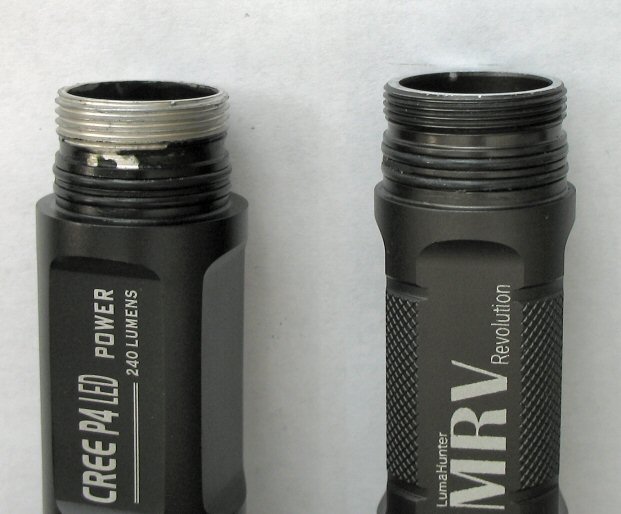
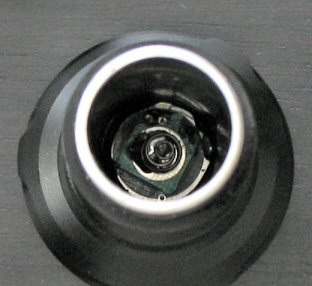
Tailcap and switch: Again, quality and number of extras on the DX lights are definitely not as high as the premium lights. MRV/A8 use the same switch (DX Cree Projection light on left, MRV on the right in the photo below), and the DBS has a forward clicky. Quality of the DX components are similar to the best of the various $20-30 EYJ/MTE lights that DX sells (which are generally acceptable but nothing special). Note that the sequence for the DX tailcap is Hi first, followed by Low, then off.
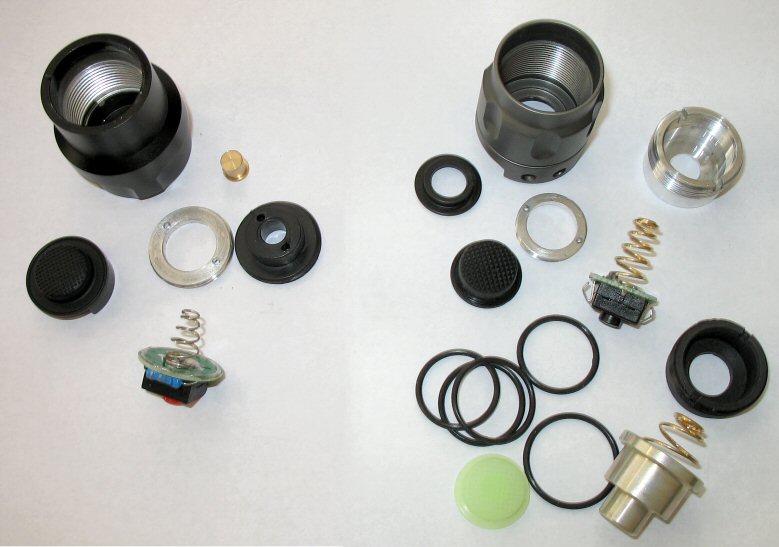
--------------------------
I'll continue to update this thread with more observations as I play with all the lights. :thumbsup:
This overview is my first throw and runtime comparison of the premium thrower lights (Dereelight DBS, Tiablo A8, and Lumapower MRV) and the budget versions (DealExtreme "3W Cree Projection" and WF-600). Scroll down for a detail review of the DBS V1 and Projection Cree.
For an updated detailed comparison to all the other thrower lights in my collection, please see:
Thrower review: DBS, Spear, MRV, Tiablo, Regal & clones: THROW, RUNTIMES, BEAMSHOTS!
The contenders:
From left to right: Lumapower MRV (2nd Gen), Tiablo A8, Dereelight DBS, DX Cree Projection, DX WF-600 (18650-only). Not shown is the Regal WT1.


Beamshots:
Quick and dirty comparison at ~.4 meters from a wall, to show you the different overall spillbeam patterns. All lights are running on 18650, with Q2 emitters.

Beam observations:
- DX Cree Projection and WF-600 have a very similar beam profile to the MRV, although overall spillbeam width is a bit narrower on the DX lights
- The Tiablo A8 and Dereelight DBS have a similar beam profile to each other, with a smaller brighter hotspot, brighter corona, and smaller overall spillbeam width than the MRV
- DBS has the smallest overall spillbeam width of all the lights
- Tint on my DX Cree Projection was slightly purplish, and the WF-600 is a warm yellow. The MRVs/A8 have premium white tints (although example shown above is my MRV Q5 warm tint WG mod). The DBS 2-stage is a warm tint, consistent with the reported WD/WG bin for this module.
- Although not shown, the Regal WT1 produces a beam pattern closest to the DBS, although with a wider spillbeam (spillbeam width is intermittent between the DBS and MRV).
MRV 1st Generation (Light Gray) - P4 Throw Lux @ one meter:
- 18650 x 1 on high: 9,600 Lux
- 18650 x 1 on low: 6,200 Lux
- CR123A x 2 on high: 11,800 Lux
- CR123A x 2 on low: 5,900 Lux
- 18650 x 1 on high: 10,400 Lux
- 18650 x 1 on low: 7,100 Lux
- CR123A x 2 on high: 14,200 Lux
- CR123A x 2 on low: 7,200 Lux
- 18650 x 1 on high: 11,800 Lux
- 18650 x 1 on low: 8,500 Lux
- CR123A x 2 on high: 18,200 Lux
- CR123A x 2 on low: 8,500 Lux
- 18650 x 1 on high: 14,400 Lux
- 18650 x 1 on low: 1,690 Lux
- CR123A x 2 on high: 14,100 Lux
- CR123A x 2 on low: 2,680 Lux
- 18650 x 1 on high: 17,000 Lux
- 18650 x 1 on low: 3,600 Lux
- CR123A x 2 on high: ~19,500 Lux (estimate, see runtime graph)
- CR123A x 2 on low: 3,650 Lux
- 18650 x 1 on high: 21,200 Lux
- 18650 x 1 on medium: 10,500 Lux
- 18650 x 1 on low: 1,830 Lux
- 18650 x 1 on high: 11,200 Lux
- 18650 x 1 on low: 3,200 Lux
- CR123A x 2 on high: 14,200 Lux
- CR123A x 2 on low: 6,300 Lux
- 18650 x 1 on high: 16,300 Lux
- 18650 x 1 on low: 3,600 Lux
- 18650 x 1 on high: 10,200 Lux
- 18650 x 1 on low: 1,650 Lux
- CR123A x 2 on high: 10,650 Lux
- CR123A x 2 on low: 3,800 Lux
Throw observations:
- On 18650, the Dereelight DBS-Q2 throws further than the Tiablo A8-Q2, which in turns throws further than the Lumapower MRV-Q2. On primaries, the DBS-Q2 out-throws the A8/MRV, which are roughly equivalent. I would expect this relative throw relationship (DBS>A8>MRV) to persist for higher luminous flux bins
- Upgrading a MRV to a Q5 emitter resulted in greatly increased throw only on primaries. On 18650, my Q5 upgrade resulted mainly in runtime improvements.
- On low, the Tiablo A8 has the lowest output, followed by the Dereelight DBS and DX lights, while the MRVs are considerably brighter.
- Among the budget throwers, the multi-power DX Cree Projection-Q2 is equivalent to the Lumapower MRV-Q2 on all batteries. The 18650-only WF-600-Q2 throws as far as the Dereelight DBS-Q2, but on 18650-only.
- DBS 3-stage Q4 module (18650-only) throws the furthest of all my lights.
- Regal WT1. with its Q5 emitter but smaller reflector. is still able to throw about as far as the early generation MRVs (P4/Q2).
Runtimes:
These runtimes charts are different from my other reviews - they represent throw, not overall output. Since my home-made milk carton lightbox doesn't accurately capture overall output on these intense throwers, I have adjusted all my relative output numbers to initial throw (measured as the squareroot of Lux @1m). This allows you to directly compare the relative throw of each light over time on the graphs below (although you can't directly compare these graphs with my other reviews).


Runtime observations:
- On primaries, luminous flux bin makes the biggest difference in output, as expected. Main differences between the lights are due to the regulation characteristics of their respective circuits
- DBS 2-stage has an unusual regulation pattern on primaries, and only peaks right before drop-off (note: I ran this runtime test twice, and the pattern was similar both times)
- On 18650, flux bin makes a bigger difference for runtime than output for the multipower circuits, like in the MRV and DX Cree Projection. The Tiablo A8 is much brighter and better regulated than the other lights, but at the expense of runtime
- The Q5-modded MRV shows a considerable increase in brightness on primaries, but only a small increase on 18650. On 18650, there was a dramatic increase in runtime - nearly 50% longer (i.e. ~6 hours for Q5 vs ~4 hours for unmodded P4)
- The DBS 3-stage Q4 module (18650-only) has great regulation and output on 18650, very impressive. Unlike the Tiablo, the DBS module has a low "moon mode" rather than abrupt shut-off on 18650 (although light showed some slight flickering at this low level, so I stopped the run at this point).
- The Regal WT1 has very flat regulation on primaries, and a typical decay pattern on 18650.
Conclusions:
- Simply put, with the same emitter in place (Q2), the DBS throws further than the Tiablo, which in turn throws further than the MRV. This is likely due to deeper reflector designs of the newer lights. The flipside to this improved throw is narrower overall spillbeam width.
- The DX lights feature remarkably good output and runtimes - the DX Cree Projection is at least as good the original MRV (and slightly better regulated), which is very impressive.
- Build quality of the premium lights are all quite good, with the Tiablo having the highest grade aluminum and best anodizing among my samples. My Dereelight DBS shows machining marks in the various grooves and recesses, along with some "splotchiness" in anodizing (see below for a discussion). Earlier MRVs had some anodizing defects, and this seems to have been resolved on later versions.
- Overall build quality of DX lights are certainly not the same as the premium MRV/A8/DBS class by a long shot - but it is at the higher end of the lights DX typically sells. If you are comfortable with this class of light, you should find these budget throwers a great deal at <$30
- In general terms, increasing the flux bin on the MRV (with the stock driver) results in a differential effect on output/runtime depending on the battery used: on primaries, you get mainly increased output with little change to runtime, but on 18650 most of the gain is in runtime improvements. This is likely due to the higher Vf on currently available Q5 bins.
- The 3-stage Q4 (18650-only) module on the DBS is the clear throw king of my comparison so far.
- The Regal WT1 is not meant to be a dedicated thrower, but as you'll see above, it holds its own very well given the head/reflector size.
------------------------
Dereelight DBS Mini-Review
Build Quality:
- The overall design of the DBS is top-notch. All the parts are easy to access and disassemble - very modular, very well designed. However, the large number of contact surfaces and screw threads suggests proper maintenance will be critical on this light. Haven't done detailed pics, but see WadeF's review for pics: Dereelight DBS review!
- The emitter module screws into the aluminum reflector, providing excellent heatsinking and easy ability to upgrade emitter modules as new emitters come out.
- The DBS weighs 220g, making it the heavyist of the lights reviewed here. It is also a bit longer than the other premium lights (Tiablo/MRV).
Machining and Anodizing:
- Unfortunately, these are the areas where the DBS disappoints somewhat. Anodizing is not as smooth as the other premium lights, with a splotchy "mottling" effect noticeable in several regions, especially around the head. A minor cosmetic issue, and not a big deal to me.
- Machining is another issue, as there are some very noticeable grooves visible in many of the scalloped regions. At close range, you can see horizontal marks that are reminiscent of the peaks and valleys of old-style phonograph records (but much finer, of course). The two pics below, from the head and taicap, should give you an idea what I mean. Note that you won't feel these by running your finger over the areas, but they are quite visible in the light. They are certainly more noticeable than the anodizing blemishes.


Body and threads:
- Screw threads are cut well, but all lack anodizing so battery lock-out is not possible (note: only the MRV features a tailcap lock-out). Current is carried through the many screw threads, so proper cleaning and lubing is critical.
- My sample needed a through cleaning on arrival, as some sort of grease had made its way from the threads and o-rings on to some of the contact and external surfaces. This resulted in flickering and poor contact. I generally recommend deoxit for cleaning and nyogel for lubrication.
Tailcap and switch:
- The DBS features the much sought after forward clicky! Fans of this type of switch may rejoice, although I'm personally quite happy with standard reverse clickies (I'm not often in "tactical" situations, unless you count accidentally waking my wife up at night with a light
).
- Haven't fully disassembled the tailcap innards yet, but they look to be of very high quality.
DBS Summary:
- Well designed light, best throw of all the lights reviewed here (when matched with equivalent emitters). But also narrowest overall spillbeam width.
- Modular construction allows for easy upgrade path, but multiple contact surfaces and screw threads mean more vigilant care and maintenance is required than for most lights.
- Noticeable issues with exterior machining and anodizing in this early sample. Light also suffered from contact issues as shipped, but these were resolved with proper cleaning and lubing.
- Note that my sample is one of the first DBS lights sold. Early MRVs also had anodizing, screw thread, and low mode contact issues that were all subsequently resolved.
- New 3-stage modules should be shipping with Q5 emitter, but my Q4 is no slouch! Output has increased by ~15% over the Q2 emitter, with much better regulation (as you would expect from a 18650-only module).
-------------------------
Regal WT1 Mini-Review
I suggest you check out Stefan's excellent detailed review of this light for more info:
Regalight WT1 - A Massive Performer! With beamshots & Runtimes!
I agree completely with Stefan's assessment of the build quality of this light. Machining and anodizing are excellent, very substantial feel in the hand. I'd say overall build quality-wise, it's around the level of an MRV or Tiablo (which is higher than the DBS). Excellent marks all around. :thumbsup:
Light comes with a single-stage "tactical" forward clicky and an extra 2-stage reverse clicky (with resistored low mode, similar to most of the other other lights reviewed here). My 2-stage switch has exactly the same output as the single-stage on Hi. Light also comes with a OP reflector, wrist lanyward, and a basic-model holster.
The only slight negative on mine is the beam pattern. With the smooth reflector, the beam is ringier than my LP, Tiablo and DBS lights similarly equipped (the DBS was the previous "ringiness" winner among my lights
The conclusion here is that my Regal WT1 throws as far as my MRV-Q2 on 18650, and about as far as my MRV-P4 on primaries. It also has a very nice low mode (except on RCR, where it is similar to the MRV low). It's hard to estimate overall output on such throwy lights, but I'd say it seems to at least match that of my Q2 lights overall.
All in all, I'm happy with the light. Seems to be good value for the money. You basically get original P4/Q2 MRV output - with similar build quality - but in a smaller, more portable form-factor. :thumbsup:
-------------------------
Budget Thrower Mini-Review: DX Cree Projection and WF-600
- There is a major point of confusion here - it many cases, DX shipped the same light for both models. Early versions of the WF-600 were sold with the same multipower circuit as the Cree Projection. And after the initial batch of P4 Cree Projections, these began shipping with Q2 emitters (despite ongoing P4 body label). Thus, many users report receiving identical lights. However, the WF-600 unit I recently received (Oct 2007) does have the correct 18650-only circuit.
- The host for these two lights is virtually identical - it is only the circuit and body labelling that differ. There is also some variability in anodizing finish (i.e. glossy or matte). Both of my lights seem to use Q2 Cree emitters.
- The Cree Projection seems to have a virtually identical multipower circuit to Lumapower MRV, and output and runtime are comparable to a Q2-equipped MRV.
- The WF-600 on 18650 is ~25% brighter (with ~25% more throw) than the Cree Projection on 18650. Consistent with this greater output, runtime is reduced on the WF-600.
- The DX Cree Projection and WF-600 have identical bodies. Their weight is the same weight as the MRV/DBS (200g), which is heavier than the A8 (150g). The lights are ~13mm longer and ~9mm wider at the bezel than the MRV.
Beamshots
For simplicity, I'm only showing the DX Cree Projection and Luma MRV-Q2 (2nd gen) on 18650 on Hi, at two different exposures to show the beam profiles.


Reflector: The DX lights have a wider and longer reflector than the MRV (shown below), but are made of plastic instead of aluminum. They also have a wider opening, making it much harder to center properly around the emitter (the emitter simply has a shiny reflective disk surrounding it). On the MRV or A8, the reflector fits very snuggly around the Cree emitter ring, making proper placement a snap. The DBS is even better, as the emitter module actually screws into the reflector, insuring centering.


Body and threads: The DX lights have surprisingly good "hand feel", due to their overall heft. Although bulkier than the premium lights, the DX units seem well balanced in the hand, and the Type II anodizing is smooth on the visible surfaces (premium MRV/A8/DBS are HA, type III). As you can see in the pic below, tailcap threads not anodized, and quality is not as high as the MRV (although still acceptable). I haven't disassembled the head yet, but if you look down the barrel you'll see the positive contact is just a steel spring soldered to a circuit board (in contrast, see Stefan's threads for detailed pics of the high quality design of MRV/A8 heads).


Tailcap and switch: Again, quality and number of extras on the DX lights are definitely not as high as the premium lights. MRV/A8 use the same switch (DX Cree Projection light on left, MRV on the right in the photo below), and the DBS has a forward clicky. Quality of the DX components are similar to the best of the various $20-30 EYJ/MTE lights that DX sells (which are generally acceptable but nothing special). Note that the sequence for the DX tailcap is Hi first, followed by Low, then off.

--------------------------
I'll continue to update this thread with more observations as I play with all the lights. :thumbsup:
Last edited:




